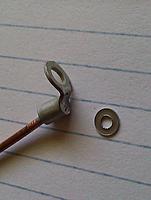Archive for February, 2013
-
 Views: 395
Views: 395
Figure 1: Spare parts gathered from around the house for creating a simple wire pointer: a short length of bare copper wire, an electrical eye connector, a white post card, and Scotch tape. -
 Views: 356
Views: 356
Figure 2: The electrical eye connector is soldered onto the end of the copper wire and then bent over 90-degrees. -
 Views: 355
Views: 355
Figure 3: The wire is fastened to the bottom of the balancer using an existing screw to avoid drilling a new hole into the carbon fiber material. -
 Views: 384
Views: 384
Figure 4: Two pieces of Scotch tape affix the post card to the balancer, and a zero-degrees line is penciled on the post card for calibrating the balancer. -
 Views: 355
Views: 355
Figure 5: The balancer is calibrated to zero by moving the post card until the zero-degrees line is aligned with the wire. -
 Views: 373
Views: 373
Figure 6: Using the calibrated blade balancer with new 450-sized Align main blades.
Comments (0)
Add Comment

